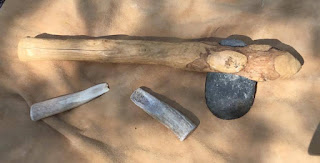Wanted to do an impromptu experiment. First, I picked the warmest, humid morning I could find while visiting family in Missouri. I had read a paper on the use of antler wedges to fell trees, in the Yukon, by indigenous peoples 3000 years ago. I was curious how well antler wedges would do downing 2-inch diameter shelter poles. To compare, I cut one tree using a Virginia greenstone celt axe I had pecked. I had a couple of medium sized white tail deer antler wedges, and for the mallet I used the axe handle with the celt removed. What did I learn? Energy-wise, the axe was harder effort to use & control, shredded the sapling more in the process. The antler wedge and mallet were easier, and cleaner, incising around the pole with more precision. The sapling was bent and the wedge used to cut thru the stressed fibers. The first wedge I used, I saw my mistake I made, when I ground it down. I ground from two sides putting some of the pithy area of the antler on the working edge. This started flaking away after a few strikes. So, I switched to the wedge I had only ground from one side, leaving the strong dense outer layer as the edge. This worked fine. I did notice a small area peeled back which could easily be ground again. Both methods took about the same amount of time on green wood. My opinion...I like the antler wedge. It’s a cleaner cut, easier to use, lighter to carry, faster to re-grind...something I need to play around with more. I reviewed a number of archaeological site inventories and noticed awls and wedges were the most numerous bone/antler items recovered. As an over sight, I simply had not really considered the value of wedges in the primitive tool kit. But, you need a wedge to split the wood to make a bow, thin a fireboard, create an atlatl blank, and more.
Subscribe to:
Post Comments (Atom)












No comments:
Post a Comment